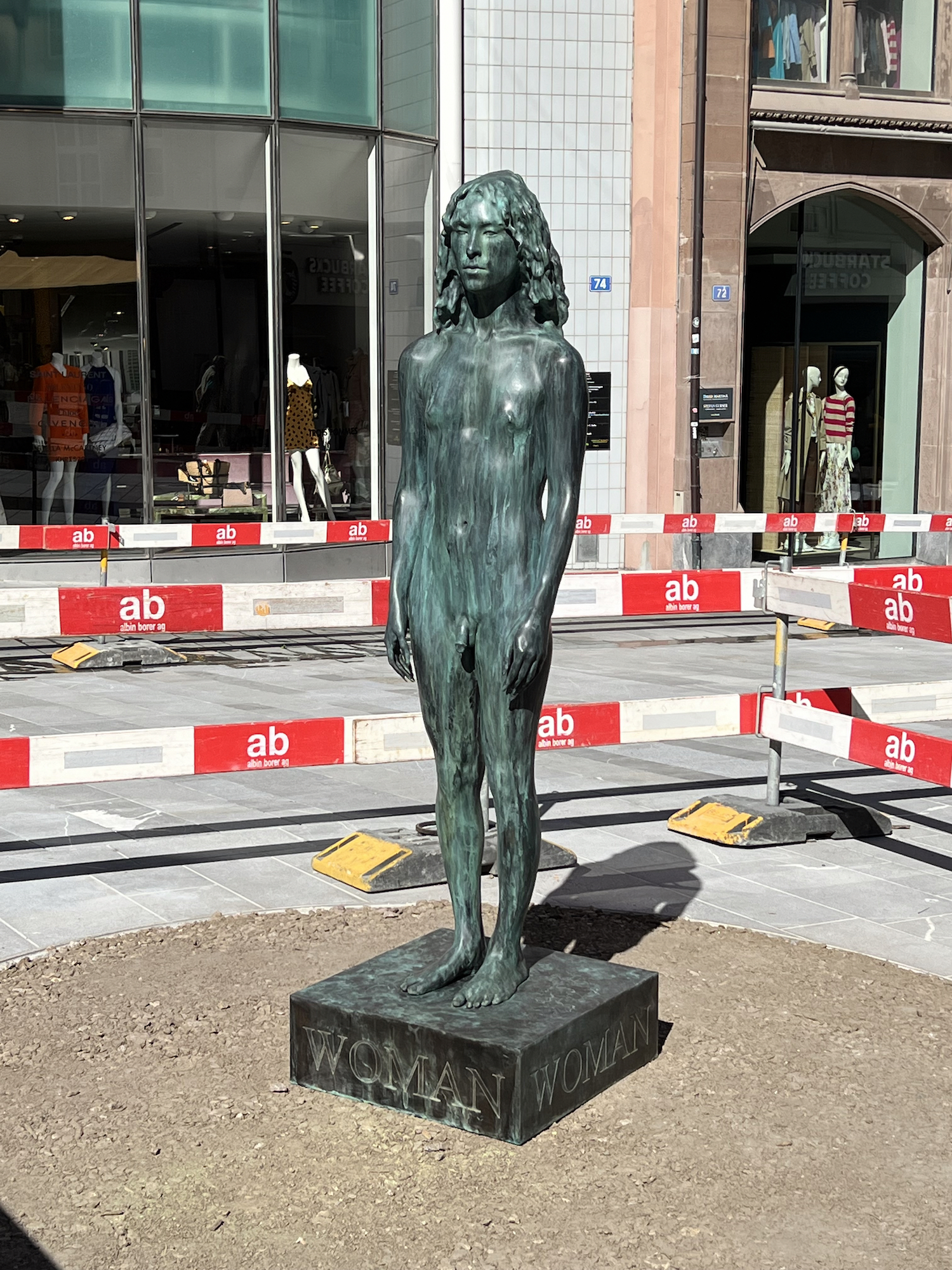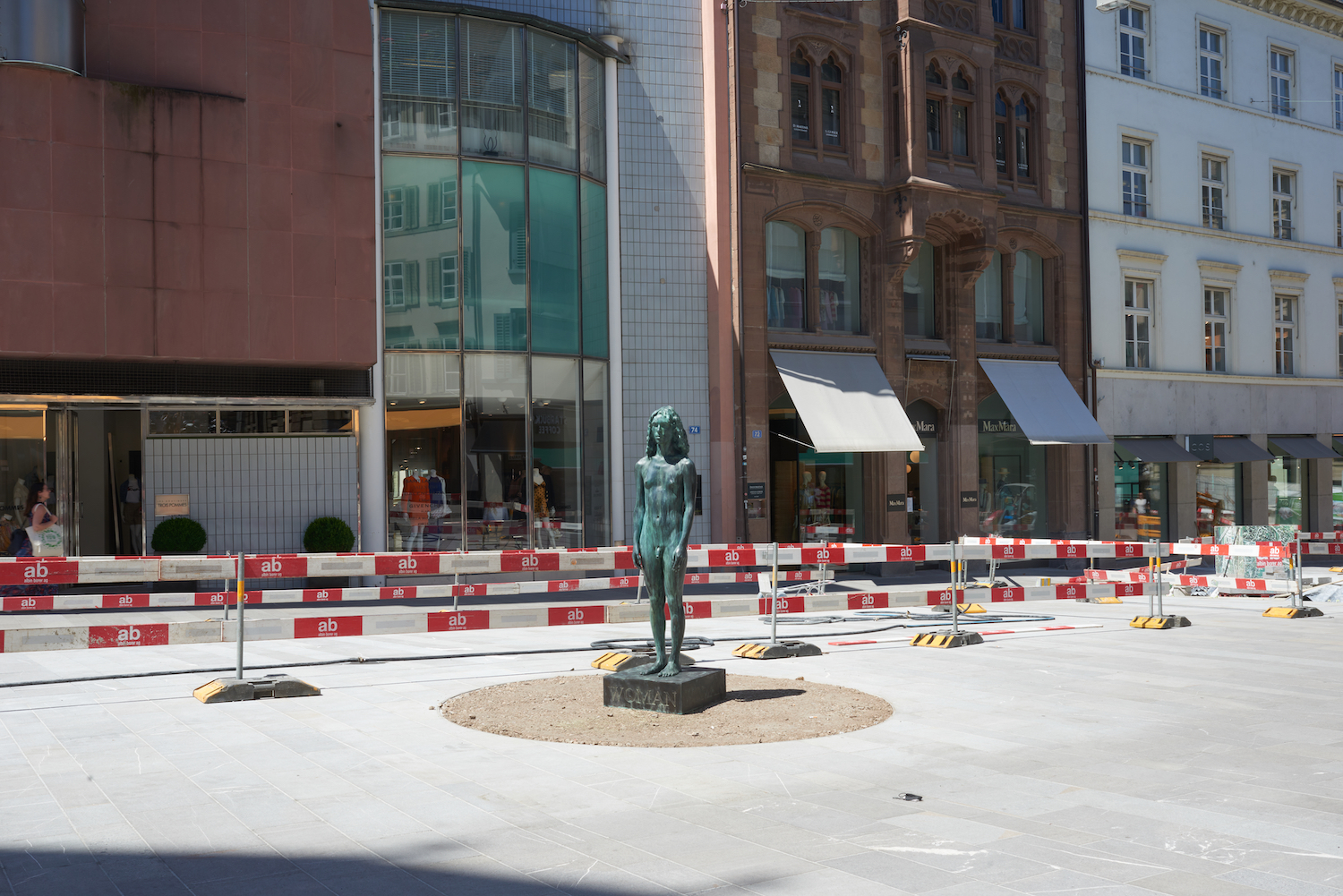Taking down statues is so 2020. From Rhodes Must Fall to the toppling of Edward Colston at a Black Lives Matter protest in Bristol, the representational power of public bronzes has never been placed under sharper scrutiny. So in 2022, it’s all about erecting new statues instead. Puppies Puppies (Jade Guanaro Kuriki-Olivo) forcefully answers the question — “What and who should we valorise in our contemporary society?” — with her new public work unveiled at Art Basel on Monday. Taking the familiar form of a public bronze, Kuriki-Olivo naked, trans, indigenous body stands on a plinth with a single word inscribed on each side: ‘WOMAN’. The work is uncompromisingly clear: trans women are just that, women.
Kuriki-Olivo’s work started much more opaquely. She shot to notoriety in 2016 under the guise of the enigmatic persona Puppies Puppies. Part performance art, part sculpture, her earlier work often involved the artist appearing in full-body pop-cultural costumes in art spaces across the world — Olaf from Frozen appeared in galleries, SpongeBob SquarePants appeared at art fairs, the Statue of Liberty appeared at the Whitney Biennial. The costumes obscured her identity entirely, with some viewers questioning whether the artist herself was actually under the costume at all. With her ex-husband often taking interviews on her behalf, few knew the true identity of the mysterious artist.
“As a queer person anonymity is nothing new. I hid to survive the surroundings of my upbringing and to keep myself safe from society’s deeply rooted colonial transphobia and queerphobia,” she writes over WhatsApp on a Sunday evening. “But I was also hiding because I felt my identity would be exploited and commodified within art. I am a trans woman, I am a two-spirit person, I am Puerto Rican (Boricua), Japanese and Indigenous, I am a brain tumour survivor.”

It was not until 2018 that Kuriki-Olivo publicly revealed her trans identity. Her practice shifted to work that dealt unapologetically with her identity and contemporary queer politics. Take her 2019 show BODY FLUID (BLOOD) at Remai Modern, which included a vat of her own blood surrounded by a floor of blood-drop-shaped stress balls as a case in point. The show brought attention to legal barriers queer people face in donating blood and sought to de-stigmatise HIV by offering on-site testing, demonstrating a commitment to social responsibility that Kuriki-Olivo attributes to the blurred boundaries between her life and her art.
“I am a compilation of every experience I’ve ever had. This inherently affects the work — as life flows so does the river of creativity and expression from my brain. I transitioned and my work transitioned as well. But expressing my truest self as a trans woman is scary – you never know what might happen in this anti-trans world,” she says. “However, I realised that hiding in complete anonymity meant something different as a trans woman of colour. I needed to overcome the fear and fight the fight through my art, life and activism. I want a future generation to see what’s possible. I want to honour the brave ‘transcestors’ who were visible in times when the laws forbid us from existing.”
In another 2019 work, Naked Self (Transitioning)(19 Months On Hormone Replacement Therapy), Kuriki-Olivo found a way to further politicise the unveiling of her identity. During this stark performance piece, she stood alone, naked in Balice Hertling’s gallery space in Paris. A proud reclamation of bodily autonomy, the work recognised the power of the artist’s body.
“My naked body is inherently political. I stand naked as a trans woman in art institutions because throughout art history, images and sculptures of trans people have been erased, desecrated, or made solely through the lens of the cis male gaze,” she says. “Through performance, through text art, through video, through sculpture, through many forms, I want to take back the autonomy of my image as a trans woman of colour.”

Her new sculpture in the centre of Basel transposes this power of trans nudity out of the arts institution and into a civic sphere. By monumentalising herself as a classic bronze, she grants the wider public access to the naked trans body. When the trans body is often stigmatised and shrouded in mystery, this autonomous presentation of the naked self becomes a radical act. “It’s a naked trans body created by the trans person it depicts. Gender is a construct, genitals do not determine gender, chromosomes do not determine gender,” she says. “My naked body inherently breaks the binary and reveals the reality that gender is a spectrum spinning in all directions. I am not what I was ‘assigned’ at birth, but for many, many people today, this is still a difficult or impossible notion to grasp. Transphobia has to be unlearned. In some ways I use my work to help assist in unlearning, which itself is a form of teaching generated from my lived experience.”
It’s title, in full, is a list forcefully declaring trans resilience — an unashamedly direct and political title demonstrating her earnest obligation to trans activism: A sculpture for Trans Women A sculpture for the Non-Binary Femmes A sculpture for Two-Spirit People • I am a woman. I don’t care what you think • (Transphobia is everywhere and everyone is susceptible to enacting it at any moment) (Unlearn the transphobia brewing within) I am a Trans Women. I am a Two-Spirit Person. I am a Woman. This is for my sisters and siblings everywhere. History erased many of us but we are still here. I will fight for our rights until the day I die. Exile me and I’ll keep fighting.
“I find myself thinking ‘it is my duty to fight for our freedom’, which is often chanted at the protests I attend,” she says. “Personally, I couldn’t have a voice in this world as a trans woman and not fight for trans rights, for an end to worldwide transphobia. Equity for trans people is what I’m pleading for with this work (and in my very existence and activism). Trans bodies and trans people are sacred and should be treated as such.”
Puppies Puppies’ sculpture is on view at Freie Strasse × Bäumleingasse , Basel Switzerland for Art Basel Parcours. artbasel.com
